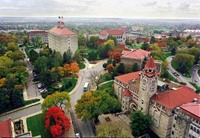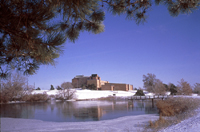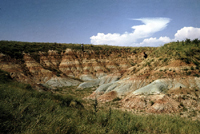41st Annual Meeting of the South-Central Section
41st Annual Meeting of the North-Central Section
Geological Society of America
Lawrence, Kansas, 11-13 April 2007
| The Kansas Geological Survey, the Department of Geology, and the Department of Geography of The University of Kansas will host the 2007 joint annual meetings of the South-Central and North-Central Sections of the Geological Society of America. The meeting dates will be from Wednesday, April 11, to Friday, April 13, at the Kansas Union on the University of Kansas campus, Lawrence, Kansas. | ||
| The University of Kansas (KU) is a major research and teaching university with over 29,000 students and over 2,200 faculty members at the Lawrence, Edwards, and the Medical Center campuses. Research expenditures at KU exceeded $274 million in 2004 with more than $155 million from external sources. Immediately adjacent to the meeting site at the Kansas Union are the KU Natural History Museum (with paleontological displays including marine reptiles, dinosaurs, fishes, mammals, invertebrates, and plants) and the KU Spencer Museum of Art. KU has strong traditions in geologic and paleontologic research. |
 Areal View of the University of Kansas Campus |
|
 Kansas Geological Survey, photo by John Charlton |
The Kansas Geological Survey (KGS) is a research and service organization operated within KU that conducts geologic studies and research and collects, correlates, preserves, and disseminates information leading to a better understanding of the geology of Kansas. The KGS is a leader in geologic, energy, ground-water, and geophysical research. Topics of KGS publications include computer applications, ground-water, petroleum, engineering geology, geochemistry, geophysics, paleontology, mineral economics, and stratigraphy. The KGS employs more than 60 geologists, geohydrologists, geophysicists, computer scientists, and other specialists. The Data Access and Support Center, the GIS data repository for the State of Kansas, is housed at the KGS. The KGS also operates a branch office in Wichita, the Wichita Well Sample Library. | |
| The Department of Geology's 19 faculty direct a program of research, service, and teaching. It introduces 4,000 to 5,000 KU students to the Geosciences each year, and its 65 graduate students and 78 undergraduate majors receive a diverse and cutting-edge education. The undergraduate curriculum focuses on fundamentals, field experiences, and new approaches. The graduate program excels in advanced training and research. With $6 million in grant funding and approximately 60 peer-reviewed papers published yearly, it is a hub of research activity. It boasts excellent programs in sedimentology/stratigraphy, geochemistry, petroleum geology, paleontology, environmental geology/hydrogeology, tectonics, high-resolution geophysics, and geobiology. It is the home of the Keck Plasma Analytical Lab, Keck Paleoenvironmental Stable Isotope Lab, U-Th/He and TIMS Isotope Geochemistry Lab, the journal Palaios, and the Treatise on Invertebrate Paleontology. |
 Permian-Cretaceous boundary, McPherson County, photo by Grace Muilenburg |
|
 Glacial Till, Wabaunsee County, photo by John Charlton |
With over 20 faculty members, the Department of Geography at KU consists of geography and atmospheric sciences and is a leader in remote sensing and GIScience. Close affiliates of the department are the Kansas Applied Remote Sensing Program (KARS) and the National Center for Remote Sensing of Ice Sheets (CReSIS). Physical geography research and education focuses on Quaternary geology and soils geomorphology, isotope geochemistry and geoarchaeology. | |
| Lawrence, Kansas, is a city with a population of 88,000 ~35 miles west of Kansas City, and is located in a terrane of gently westward-dipping Pennsylvanian strata. The intersection of the Oread Escarpment with the Kansas and Wakarusa River valleys at Lawrence highlights a cuesta landscape featuring rolling hills and beautiful vistas. The KU central campus is located on the dipslope rim of the Oread Escarpment, and can be seen for miles when approaching from the east and south. Mid-April is a delightful time to visit Lawrence and the KU campus. Beautiful and historic downtown Lawrence is located at the foot of the Oread Escarpment just to the east of the KU campus. Lawrence has a vibrant arts community and a wonderful downtown shopping, dining, and bar district with commercial and public art galleries, the Watkins Museum, and a variety of live music venues. Other restaurants, bars, and shopping centers are spread throughout the city. To learn more about Lawrence, visit the following web sites: City of Lawrence, Lawrence Convention and Visitors Bureau, Lawrence Journal-World Newspaper, and Lawrence.com. | ||
 Downtown Lawrence, photo by John Charlton |
||
Travel and Transportation
Lawrence is located along the Kansas Turnpike (I-70). Air travelers to Lawrence should use Kansas City International Airport (MCI) for air transportation and rental car services. Kansas City International Airport is only a one-hour drive (49 miles) away from Lawrence. Airport shuttle service to Lawrence is provided by Ground Transportation Inc. (888-467-3729) and KCI Roadrunner (800-826-8294). Contact these providers prior to traveling for times and pickup information. Amtrak offers two trains per day (one westbound and one eastbound) to Lawrence. Travelers by rail should plan ahead for taxi or other pickup at the Amtrak station, because the trains arrive at night and no services are available at the station. Public transportation is provided by the Lawrence Transit System. Their website has maps (PDF file) and schedules.
Accommodations
Blocks of rooms have been reserved at the Best Western Lawrence (785-843-9100), Hampton Inn (785-841-0265), Holiday Inn Holidome (785-841-7077), Holiday Inn Express (785-749-7555), and Eldridge Hotel (785-749-5011).
Maps
- Kansas City to Lawrence with Kansas City International Airport
- Meeting Hotels/Motels
- University of Kansas with Kansas Union
Photos
Additional Photographs of Kansas can be found in the Kansas Geological Survey on-line Photo Library.
Registration
Standard Registration Deadline: March 12, 2007
Cancellation Deadline: March 19, 2007
GSA Headquarters will handle meeting registration. Registration will be available online at www.geosociety.org. On-site registration will be available during the meeting at the Kansas Union on the University of Kansas Campus.
Call for Papers |
||
|
Abstract Deadline: January 23, 2007 Papers are invited for symposia, theme, and general discipline sessions in both oral and poster format. Volunteered papers will be considered for any general discipline session as listed on the GSA abstracts form. Only one volunteered paper may be presented by an individual; however, a person may be a co-author on other papers. Individuals invited to present to a symposium may present one additional paper. All abstracts must be submitted online at www.geosociety.org. An abstract submission fee of $10 will be charged. If you cannot submit your abstract electronically, please contact Nancy Carlson 1-303-357-1061, ncarlson@geosociety.org. |
 Monument Rocks, Niobrara Chalk, Gove County, photo by John Charlton |
|
Technical Program
Symposia
- Pander Society Symposium--Mixed-Up Conodonts: Extracting Useful Information and Solving Geologic Puzzles Using Stratigraphic Leaks and Redeposited Faunas. Pander Society and Paleontological Society. James Miller, Missouri State University, JimMiller@MissouriState.edu; Stephen Leslie, University of Arkansas at Little Rock, saleslie@ualr.edu. Oral and Poster
- Roger L. Kaesler--Scientist and Editor: His Contributions to Paleontology Through Research and the Treatise on Invertebrate Paleontology. Paleontological Society. Bruce S. Lieberman, University of Kansas, blieber@ku.edu. Oral only
Theme Sessions
- Microbial Methane Energy Resources. George W. Shurr, GeoShurr Resources, LLC, geoshurr@frontiernet.net; Fred J. Anderson, North Dakota Geological Survey, fjanderson@state.nd.us. Oral and Poster
- Hydrothermal Processes in Midcontinent Sedimentary Rocks. Great Lakes Section, SEPM. John Luczaj, University of Wisconsin, Green Bay, luczajj@uwgb.edu; Robert H. Goldstein, University of Kansas, gold@ku.edu. Oral only
- Applications of Stable Isotopes to Modern and Quaternary Environmental Issues. William C. Johnson, University of Kansas, wcj@ku.edu; Luis Gonzalez, University of Kansas, lgonzlez@ku.edu. Oral and Poster
- Identification of Environmental Processes Using Isotopic Tracers. Margaret Townsend, Kansas Geological Survey, townsend@kgs.ku.edu; Roy Spalding, University of Nebraska, Lincoln, rspalding1@unl.edu. Oral and Poster
- Groundwater flow and transport processes in carbonate aquifers. Martin Appold, University of Missouri, Columbia, appoldm@missouri.edu; Carol Wicks, University of Missouri, Columbia, wicksc@missouri.edu. Oral and Poster
- Early Pleistocene Glaciation of the central Plains. Wakefield Dort, University of Kansas. Oral and Poster
- Loess and Paleoenvironments. Randall Schaetzl, Michigan State University, soils@msu.edu. Oral and Poster
- Geoarchaeological and Geomorphological Explorations in the Midcontinent: Papers in Honor of Wakefield Dort, Jr. William I. Woods, University of Kansas, wwoods@ku.edu; Rolfe D. Mandel, Kansas Geological Survey, mandel@kgs.ku.edu; William C. Johnson, University of Kansas, wcj@ku.edu. Oral and Poster
- Geophysics in the Midcontinent. Kevin Mickus, Missouri State University, kevinmickus@missouristate.edu. Poster only
- Community Based Service Learning in the Geosciences. Central Section, National Association of Geoscience Teachers. Kathleen Bower, Eastern Illinois University, kmbower@eiu.edu. Oral only
- Issues in Geoscience Education. Central Section, National Association of Geoscience Teachers. Annabelle Foos, University of Akron, afoos@uakron.edu. Oral and Poster
- Strategies for Success in Bridging the Gap Between Culture, Religion, and Science in the Geoscience Classroom. Sadredin C. Moosavi, Walden University, smoosavi@waldenu.edu; Elizabeth Heise, University of Texas at Brownsville, eheise@utb.edu. Oral only
- Poster Session on Undergraduate Research. Council on Undergraduate Research, Geoscience Division. Robert Shuster, University of Nebraska-Omaha, robert_shuster@mail.unomaha.edu. Poster only
- Medical Mineralogy Session and Panel Discussion. A. Umran Dogan, Ankara University, Turkey and University of Iowa, umran-dogan@uiowa.edu, Meral Dogan, Hacettepe University, Turkey, meralmdogan@hotmail.com. Oral and Poster
- Traces of Life: Micro- to Macroscopic Evidence of Past and Present Biogenic Activity and Their Implications for Marine and Continental Settings. Paleontology Society. Stephen T. Hasiotis, University of Kansas, hasiotis@ku.edu; Jennifer A. Roberts, University of Kansas, jaroberts@ku.edu; David Fowle, University of Kansas, fowle@ku.edu. Oral and Poster
- Fossils and Modern Analogs: Using Modern Organisms to Improve Paleontological Interpretations. Paleontology Society. Daniel I. Hembree, Ohio University, hembree@ohio.edu; Brian F. Platt, University of Kansas, bfplatt@ku.edu; Jon J. Smith, University of Kansas, jjsmith@ku.edu. Oral only
- Paleontologic Deviates: Taphonomy and Pathology. Paleontology Society. Bruce Rothschild, Northeastern Ohio Universities College of Medicine, bmr@ku.edum; Larry Martin, University of Kansas; ldmartin@ku.edu. Oral only
- Systematic Paleontology in the 21st Century: Analyzing Evolution, Diversity, and Beyond. Paleontology Society. Alycia L. Stigall, Ohio University, stigall@ohio.edu. Oral and Poster
- Sequence Stratigraphy and Biostratigraphy of Pennsylvanian-Lower Permian Cyclothems in the North American Midcontinent. Paleontology Society. Gregory P. Wahlman, BP America, Gregory.Wahlman@bp.com; Philip H. Heckel, University of Iowa, philip-heckel@uiowa.edu. Oral only
- The Legacy of Raymond Cecil Moore (1892-1974): The 20th Century's Paleontologist/Stratigrapher Laureate. Daniel F. Merriam, University of Kansas, dmerriam@kgs.ku.edu; Paul Enos, University of Kansas, enos@ku.edu. Oral and Poster
- Neogene Depositional Environments Paleoclimatology, and Stratigraphic Architecture of the Succession Forming the High Plains Aquifer. P. Allen Macfarlane, Kansas Geological Survey, dowser@kgs.ku.edu; Greg Ludvigson, Kansas Geological Survey, gludvigson@kgs.ku.edu; Marios Sophocleous, Kansas Geological Survey, marios@kgs.ku.edu. Oral and Poster
- Upper Paleozoic Depositional Systems, Cyclo- and Sequence Stratigraphic Architecture, and Their Controls on Hydrocarbon Reservoirs in the Midcontinent of U.S.A. Wan Yang, Wichita State University, wan.yang@wichita.edu; Salvatore J. Mazzullo, Wichita State University, salvatore.mazzullo@wichita.edu. Oral and Poster
- Insights from Cretaceous-Paleogene Paleoenvironments and Deposition: Glimpses of the Greenhouse. Brian J. Witzke, Iowa Geological Survey, bwitzke@igsb.uiowa.edu; Greg A. Ludvigson, Kansas Geological Survey, gludvigson@kgs.ku.edu. Oral and Poster
- Geologic Framework of the U.S. Continental Interior. Mary Hubbard, Kansas State University, mhub@ksu.edu; Daniel Holm, Kent State University, dholm@kent.edu; Stephen Marshak, University of Illinois, smarshak@uiuc.edu. Oral and Poster
- Hydrologic and Water Quality Investigations in Floodplain Aquifers in the Midwestern U.S. Marcia K. Schulmeister, Emporia State University, mschulme@emporia.edu; Brian P. Kelly, United States Geological Survey, bkelly@usgs.gov. Oral and Poster
- Establishing Teacher-Scientist Collaborations in K-12 Earth Science Education. Charles Spencer, Central Missouri State University, spencer@cmsu1.cmsu.edu. Oral and Poster
- Applied Hydrogeology and Geophysics: Innovative Approaches to Old Hydrogeological Challenges. Amir Mokhtari Fard, Hydro Research, Täby, Sweden amfard@hydroresearch.se, Oral and Poster
- Geologic Hazards in Urban Areas and Transportation Corridors of the Midcontinent. Gregory Ohlmacher, Kansas Geological Survey ohlmac@kgs.ku.edu, Oral and Poster
Workshops
- Advancing Understanding of Ground-water Concepts Using Simulation and Role-Play in the Plume Busters Software. Saturday, April 14, 8:30 a.m. to 12:30 p.m. P. Allen Macfarlane, Kansas Geological Survey, dowser@kgs.ku.edu; Margaret Townsend, Kansas Geological Survey, townsend@kgs.ku.edu; and Geoff Bohling, Kansas Geological Survey, geoff@kgs.ku.edu. Cost: $10 Max: 15
- **Cancelled** Developing Professional Development Opportunities for K-12 Teachers in Earth Science. Central Section, National Association of Geoscience Teachers. Saturday, April 14, 8:30 a.m. to 12:00 p.m. Kathleen Bower, Eastern Illinois University; Sallie Greenberg, Illinois State Geological Survey.
Short Course
- SEPM Short Course Number 51: Recognizing Continental Trace Fossils in Outcrop and Core. Paleontological Society and SEPM. Saturday, April 14, 8:30 a.m. to 5:00 p.m. Stephen T. Hasiotis, University of Kansas, hasiotis@ku.edu. Cost: $45 Max: 25
Field Trips
- Sequence Stratigraphy, Biostratigraphy, and Chronostratigraphy of the Virgilian Stage, northern Midcontinent. Saturday-Tuesday, April 7-10. Darwin Boardman, Oklahoma State University (405-744-5315) Darwin.Boardman@okstate.edu. Min.: 10; Max.: 40. Cost $250, includes transportation, 1 night lodging, lunches, guidebook.
- Fluvial-estuarine deposition in the mid-Cretaceous Dakota Formation, Kansas and Nebraska. R. Matt Joeckel, University of Nebraska-Lincoln (402-472-7520) rjoeckel@unlnotes.unl.edu; Greg Ludvigson, Kansas Geological Survey (785-864-2734) gludvigson@kgs.ku.edu. Min.: 8; Max.: 18. Cost $50, includes transportation, lunch, guidebook.
- Geology and Industrial Use of the Lamproid Occurrences in Southeast Kansas. Pieter Berendsen, Kansas Geological Survey (785-864-2141) pieterb@kgs.ku.edu. Min.: 8; Max.: 18. Cost $50, includes transportation, lunch, guidebook.
- The Weaubleau and Decaturville Impact Structures in West-Central Missouri: Sorting Out Their Ages Using Redeposited Conodonts and Crinoids in Breccias. Pander Society and Paleontological Society. Friday (evening)-Saturday, April 13-14. James Miller, Missouri State University (417-836-5447) JimMiller@MissouriState.edu; Kevin Evans, Missouri State University (417-836-3231) KevinEvans@missouristate.edu. Min.: 15; Max.: 30. Cost $95, includes transportation, 1 night lodging, 1 lunch, guidebook.
- Sequence Stratigraphy of Delta-Dominated, Mixed Carbonate-Siliciclastic Depositional Systems of the Upper Pennsylvanian Ochelata Group, Oklahoma and Kansas. Friday (evening)-Sunday, April 13-15. Peter Holterhoff, Texas Tech University (806-742-1818) peter.holterhoff@ttu.edu; Tim Demko, University of Minnesota Duluth (218-726-8340) tdemko@umn.edu. Min.: 12; Max.: 20. Cost $205, includes transportation, 2 nights lodging, lunches, guidebook.
- Geoarchaeology and Quaternary Alluvial Stratigraphy of the Claussen Site. Rolfe Mandel, Kansas Geological Survey (785-864-2171) mandel@kgs.ku.edu; Jack Hofman (785-864-2634) hofman@ku.edu. Min.: 15; Max.: 35. Cost $17, includes transportation, handout.
- Maximum Southwestern Extent of "Kansan" Ice Sheet and Newly Discovered Older Till. Sat., 14 April. Wakefield Dort, Jr., Emeritus, University of Kansas (785-864-4974). Min.: 6; Max.: 48. Cost $35, includes transportation, guidebook.
Activities
- Keynote Presentation by Dr. Herman Zimmerman, National Science Foundation--How does it work? Sponsored by GSA National Leadership Initiative, Wed., 11 April, 8:00 a.m.
- Welcoming Reception; Wed., 11 April, 5:30-7:30 p.m., Ballroom, Kansas Union, University of Kansas.
- Keynote Presentation of the Birdsall Dreiss Lecture by Bridget Scanlon, Texas Bureau of Economic Geology, Impacts of Changing Land Use on Subsurface Water Resources in Semiarid Regions; Wed., 11 April, 7:30 p.m.
- Association for Women Geoscientists Social Breakfast Meeting; Wed., 11 April, 7-8 a.m. Cost: US$10
- North-Central Section GSA Management Board Breakfast Meeting; Thurs. 12 April, 7-8 a.m.
- Great Lakes SEPM and Paleontological Society Luncheon; Thurs., 12 April, noon-1 p.m. Cost: US$20.
- South-Central Section GSA Management Board Meeting; Thurs., 12 April, 4-5 p.m.
- South-Central Section GSA Business Meeting; Thurs., 12 April, 5:30-5:40 p.m.
- North-Central Section GSA Business Meeting; Thurs., 12 April, 5:40-5:50 p.m.
- Keynote Presentation by James Kirkland, Utah Geological Survey, Utah's Early Cretaceous Dinosaur Assemblage: The China Connection; Thurs., 12 April, 6:00 p.m.
- GSA Campus Representatives and North-Central Section GSA Technical Program Advisory Committee Breakfast Meeting; Fri., 13 April, 7-8 a.m.
- Central Section, National Association for Geoscience Teachers (NAGT) Luncheon and Business Meeting; Fri., 13 April, noon-1 p.m. Cost: US$20.
- North-Central Section GSA Local Committee Meeting (2006-2010); Fri., 13 April, 5:00 p.m.
Exhibitors
Exhibit booths will be available for university, government, and companies at this meeting. For further information, please contact Gregory Ohlmacher, Gregory Ludvigson, Allen Macfarlane, or Matt Joeckel at the addresses provided below.
Contact Information
Requests for information should be addressed to the meeting chairmen, Gregory C. Ohlmacher (785-864-2194) ohlmac@kgs.ku.edu and Gregory Ludvigson (785-864-2734) gludvigson@kgs.ku.edu or meeting vice-chairmen Allen Macfarlane (785-864-2068) dowser@kgs.ku.edu and R. Matt Joeckel, University of Nebraska-Lincoln (402-472-7520) rjoeckel@unlnotes.unl.edu. Technical program questions should be addressed to Marios Sophocleous (785-864-2113) marios@kgs.ku.edu, or Tracy Frank, University of Nebraska-Lincoln (402-472-9799) tfrank2@unl.edu. Mailing address for Drs. Ohlmacher, Ludvigson, Macfarlane, and Sophocleous is Kansas Geological Survey, 1930 Constant Ave., Lawrence, Kansas 66047.
